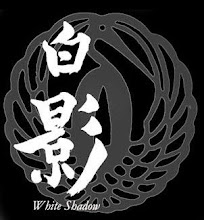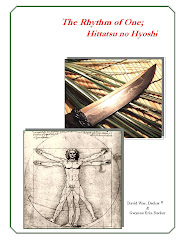
In the bottom knife, a Matt Lamey Bootlegger, we see a very different style handle which is more suited to the thumb-pinky finger grip. These handles are much broader near the pommel. The thumb-pinky method works best for broad, circular movements, ie chopping and cuts. In my opinion the thumb-pinky style also provides a slightly more secure grip, less likely to be knocked from your hand. This is good for a less confident fighter or one with a weak grip.

Which style do I prefer? This really is a personal preference and each student has to decide for themselves. Due to my past training I prefer the handle style of the top knife, thumb-forefinger. How can you determine which one best suits your hand or your style? The cheapest way would be to make one of each out of aluminum and wood. These could be used later for training purposes and will not cost you a lot of money. This is a much cheaper method than buying live blades with different style handles. (But who am I to talk?) I would suggest making these “trainers” with over-sized handles and slowly working them down with a rasp and sandpaper until they perfectly fill your hand and your style. Once you have accomplished this you could find a custom maker and send off your knife to him as a pattern. This is assuming you can find a custom maker who will build a knife to your design. If nothing else, ask him to match the handle size and configuration of your trainer. As a note of warning, I have had to remind one of my favorite makers a couple times when his handles started getting too big for my hands. How important is the handle? While, the blade is the part that does the deadly deeds, the handle is where the human operator interfaces. A properly fitting knife will feel almost weightless, a poorly fitting one, like a club.





 For years I have kept a legally registered handgun beside my bed. But I have other options as well. For example, a blindingly bright flashlight and a big bladed bowie knife. I also have a set of escrima sticks standing in the corner. They are much more maneuverable inside a bedroom than a bokken. These hardened sticks will easily crack a man’s skull or break his bones. A katana-kake (sword rack) hangs on my bedroom wall holding 5 shinken (live bladed swords). In a time of emergency they would be my weapons of
For years I have kept a legally registered handgun beside my bed. But I have other options as well. For example, a blindingly bright flashlight and a big bladed bowie knife. I also have a set of escrima sticks standing in the corner. They are much more maneuverable inside a bedroom than a bokken. These hardened sticks will easily crack a man’s skull or break his bones. A katana-kake (sword rack) hangs on my bedroom wall holding 5 shinken (live bladed swords). In a time of emergency they would be my weapons of 






